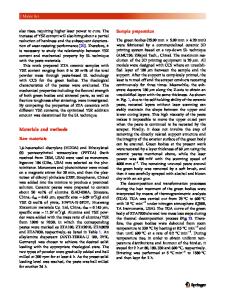Toughness determination of zirconia toughened alumina ceramics from growth of indentation-induced cracks
- PDF / 246,287 Bytes
- 7 Pages / 612 x 792 pts (letter) Page_size
- 34 Downloads / 448 Views
MATERIALS RESEARCH
Welcome
Comments
Help
Toughness determination of zirconia toughened alumina ceramics from growth of indentation-induced cracks D. Basu and B. K. Sarkar Central Glass and Ceramic Research Institute, Jadavpur University, Calcutta 700032, India (Received 27 July 1995; accepted 30 April 1996)
Short surface cracks were generated by Vickers indentation on the polished surface of alumina and different zirconia toughened alumina (ZTA) specimens, and their morphology was studied by serial sectioning. These cracks were grown in three-point bend tests under stepwise loading, and variation of toughness with crack extension was plotted to graphically separate the contributions from residual stress intensity and applied stress intensity factors. The plateau toughness determined from the intercept height of the crack extension plots exhibited an upward trend with zirconia content up to 15 vol % ZrO2 addition in the composition, which was proportional to the fraction of transformable tetragonal grains contributing to transformation toughening.
I. INTRODUCTION
The discovery of the stress-induced martensitic tetragonal (t) to monoclinic (m) phase transformation of zirconia grains in the vicinity of the crack tip has generated much interest toward the development of a new class of tough and strong ceramics having welldispersed transformable (m 2 t) ZrO2 phase in an alumina matrix (ZTA).1–4 Utilization of this material in different demanding applications needs accurate toughness determination which is not simple because these materials with high toughness often exhibit R-curve behavior. It has been reported that the material toughness determined using the maximum (plateau) toughness of the R-curve from “long crack” fracture mechanic tests overestimates the actual material toughness,5–7 which in reality is governed by the short surface cracks. To overcome this problem, indentation techniques are commonly adopted for studying the toughness of a wide range of materials by measuring the lengths of the cracks that are similar to the natural ones in dimensions.8–14 However, the development of indentation-induced cracks has considerable diversity in detailed crack geometry in both glass and ceramics13 which have added complexity to toughness determination. Further, as steeply rising R-curve behavior is often evident for most of the ceramics with higher toughness resulting in limited crack growth, it is extremely difficult to monitor the incremental lengths of the natural/indented surface cracks to determine the rising R-curve regime. The indented samples are often exposed to subsequent bending, and crack extension under bending stresses provides information about the toughness and nature of R-curve behavior.15–18 Kaliszewski et al.19 and others20 have used this technique for toughness determination of different PSZ materials with 3 and 4 mol % J. Mater. Res., Vol. 11, No. 12, Dec 1996
http://journals.cambridge.org
Downloaded: 30 Mar 2015
Y2 O3 and could study the initial, steeply rising R-curves of these material
Data Loading...











